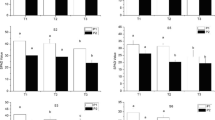Abstract
Potatoes grown for processing in irrigated regions of the Pacific North-west sometimes develop undesirably high concentrations of reducing sugars in tuber stem ends due to hot weather and water stress during tuber development. Such tubers usually produce french fries with dark stem ends or sugar ends. In order to better quantify the relationship between water stress and stem-end sugar levels for Russet Burbank, single episodes of transitory water stress were established by delaying irrigations until soil water potentials ranging from -32 to -107 kPa were reached during early tuber bulking. To determine when the increase in reducing sugars occurred, tubers were sampled before transitory stress, at maximum stress, after stress was relieved with sprinkler irrigation, and post harvest. Reducing sugar concentrations did not increase in tuber stem ends until two weeks or longer after the plant water stress was relieved. Increased reducing sugar concentrations were positively associated with decreased soil water potential (drier soil). Tubers were sliced and fried at harvest and six weeks post-harvest. Decreasing soil water potential (drier soil) was associated with progressively darker fry colors at harvest and post harvest. Significant darkening in the average stem-end fry color light reflectance of tubers at harvest as observed at -80 kPa in 1988 and -69 kPa in 1989. The effect of imposed water stress on tuber stem-end reducing sugar concentrations was most pronounced post harvest.
Similar content being viewed by others
Literature Cited
Eldredge, E.P. and C.C. Shock. 1990. Comparison of hydraulic press and pressure chamber estimates of potato leaf water potential. Am Potato J 67: 307–312.
Eldredge, E.P., C.C. Shock, and T.D. Stieber. 1992. Plot sprinklers for irrigation research. Agronomy J 84: 1081–1084.
Eldredge, E.P., C.C. Shock, and T.D. Stieber. 1993. Calibration of granular matrix sensors for irrigation management. Agronomy J 85: 1228–1232.
Hane, D.C, and F.V. Pumphrey. 1984. Yield-evapotranspiration relationships and seasonal crop coefficients for frequently irrigated potatoes. Am Potato J 61: 661–668.
Hiller, L.K., D.C. Koller, and R.E. Thornton. 1985. Physiological disorders of potato tubers.In: P.H. Li (ed.) Potato Physiology. Academic Press, New York. pp. 389–443.
Iritani, W.M., L. Weiler, and T.S. Russell. 1973a. Relative differences in sugar content of basal and apical portions of Russet Burbank potatoes. Am Potato J 50: 24–31.
Iritani, W.M. and L. Weller. 1973b. The development of translucent end tubers. Am Potato J 50: 223–233.
Iritani, W.M. and L. Weller. 1973c. Dry matter content of apical and basal portions of Russet Burbank potatoes. Am Potato J 50: 389–397.
Iritani, W.M. 1981. Growth and preharvest stress and processing quality of potatoes. Am Potato J 58: 71–80.
Lugt, C. 1960. Second-growth phenomena. Eur Potato J 3: 307.
Martin, M.W. and D.E. Miller. 1983. Variations in responses of potato germplasm to deficit irrigation as affected by soil texture. Am Potato J 60: 671–683.
Miller, D.E. and M.W. Martin. 1987. Effect of declining or interrupted irrigation on yield and quality of three potato Cultivars grown on sandy soil. Am Potato J 64: 109–117.
Nielson, L.W. and W.C. Sparks. 1953. Bottleneck tubers and jelly-end rot in the Russet Burbank potato. Res Bull No 23 Univ of Idaho Agric Expt Stat.
Penman, F. 1929. Glassy end of potatoes. J Dept of Agric Victoria 27: 449.
Ross, A.F. 1959. Dinitrophenol method for reducing sugars.In: “Potato processing”. Talburt, W.F. and Ora Smith (ed). AVI Publishing Co., Westport, Conn. p. 588.
Shock, C.C., T.D. Stieber, J.P. Zalewski, E.P. Eldredge, and M.D. Lewis. 1994. Potato tuber stem-end fry color determination. Am Potato J 71: 77–88.
Shock, C.C., Z.A. Holmes, T.D. Stieber, E.P. Eldredge, and P. Zhang. 1993. The effect of timed water stress on quality, total solids and reducing sugar content of potatoes. Am Potato J 70: 227–241.
Weaver, M.L., E. Hautala, M. Nonaka, and W. M. Iritani. 1972. Sugar-end in Russet Burbank potatoes. Am Potato J 49: 376–382.
Author information
Authors and Affiliations
Additional information
Oregon State University Agricultural Experiment Station Technical Paper Number 10,310.
Former Graduate Research Assistant, Oregon State University. This work was submitted in partial fulfillment of requirements for the Ph.D. in Crop Science, 2417 Sunset Drive, Ontario, OR 97914.
Rights and permissions
About this article
Cite this article
Eldredge, E.P., Holmes, Z.A., Mosley, A.R. et al. Effects of transitory water stress on potato tuber stem-end reducing sugar and fry color. American Potato Journal 73, 517–530 (1996). https://doi.org/10.1007/BF02851697
Accepted:
Issue Date:
DOI: https://doi.org/10.1007/BF02851697




